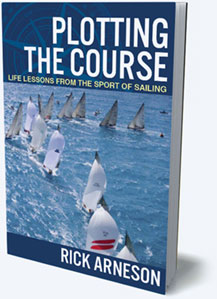Whenever Southern California experiences any kind of measurable rainfall, the roads become disaster areas with widespread auto accidents. More often than not, such accidents could be avoided by driving more conservatively, but time and again we see a driver putting the pedal to the metal as the rain begins to fall. As someone who’s crashed in the rain before, I’d like to share a sailing anecdote that illustrates the value of a little extra caution.
A while back, I was competing in the Snipe Midwinters in Clearwater, Florida. On the last day of racing, some nasty weather came through that pushed the wind over 30 knots, which is above our racing limit in the Snipe class. The races were abandoned, and the race committee signaled for all competitors to head back to the dock. The regatta leader (that should have been a hint) dropped his mainsail and started sailing in under jib alone. I, a newcomer to the fleet at the time, continued to scream along under full sail with the flawed logic of, “the faster we go, the faster we’ll get in.” Sound familiar? As I came off of a big wave, the bow of the boat plowed into the next wave ahead and the boat slowed down suddenly. When that happened, the mast took on extra load from the strong winds, and the rig came crashing down, broken in two. Whether it was because I was still unfamiliar with my boat’s limits, or because I was having a little too much fun sailing that fast, I still could have taken a cue from my competitor (an Olympian and world champion, by the way) who made it safely back to the dock without incident, while I had to be towed back by a support boat.
My sailing tale does have a relatively happy ending, though; being the last day of racing, the mast break didn’t hurt our scores, and we placed third. Better still, nobody was hurt, and a friend was able to help me replace my mast in time for the next regatta. All things considered, we were very fortunate. The lessons learned from that storm proved valuable down the line. For a while afterwards, whenever my crew wanted to convince me of some extra measures in preparing for bad weather, he’d simply say, “Remember Clearwater?” and I was sold. I’ve seen big storms many times since, but thankfully have not broken any more masts in all that time.
It’s only sensible to exercise a little bit of extra caution when a storm is on the horizon. Sometimes we get a little bit cocky and feel that the adverse conditions won’t affect us. Other times, we’re not using common sense because we’ve been shaken outside of our comfort zone. It’s far better to err on the side of caution when adversity and uncertainty strikes than to neglect our own safety and those around us. Too many So Cal drivers continue to speed along when the rain begins to fall, trying to hurry home, when slowing down to a safer speed would only cost them a matter of minutes in their trip. The Snipe sailor who took the “slow and safe” approach back to the dock had it right; by the time I had been rescued, towed back to the dock, and finished picking up the pieces, he was already showered and relaxing in the bar. And he still had a mast.
Rick Arneson, M.B.A., is the author of Plotting the Course and a competitive sailor with over three decades of sailing experience.












